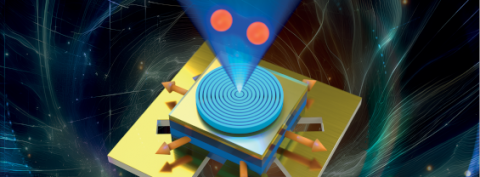A source of entangled photons based on a cavity-enhanced and strain-tuned GaAs quantum dot

Researchers from the Nanophotonics group of the Department just published an article entitled "A source of entangled photons based on a cavity-enhanced and strain-tuned GaAs quantum dot" in the journal eLight, reporting on a cutting-edge method for generating entangled photons, vital for the future of secure quantum networks. This work is the result of a wide collaboration between different European Universities and Research Centers and was coordinated by Dr. Michele Rota and Prof. Rinaldo Trotta.
Advancements in Quantum Photon Sources
Quantum communication critically relies on the development of near-ideal sources of entangled photons. However, traditional entangled photon sources, i.e., spontaneous parametric down-conversion crystals, face challenges in simultaneously achieving high brightness and a high degree of entanglement. Semiconductor quantum dots are arguably one of the most promising quantum emitters with the potential to overcome this tradeoff but, so far, researchers have developed approaches that only optimize one of these parameters at a time. In this work, the researchers have developed a novel device based on a single quantum dot, embedded in a photonic cavity and manipulated with strain-tuning techniques.
Key Features of the Device
The new device incorporates a GaAs quantum dot within a circular Bragg resonator, paired with a piezoelectric actuator for manipulation of the strain tensor. The main achievements of this new device are:
• Enhanced Brightness: The Bragg resonator engineers the light-matter interaction, achieving extraction efficiencies up to 69%.
• High Degree of Entanglement: The piezoelectric actuator manipulates strain fields to tune the quantum dot, generating entangled photons with fidelities corrected to a maximally entangled state up to 96%.
Impact on Quantum Communication
While challenges remain in achieving even higher brightness and perfect indistinguishability of the entangled photons, this research marks a significant leap forward in making quantum key distribution more efficient and reliable. The high brightness and degree of entanglement achieved by this method could lead to more practical and scalable quantum communication systems.
Authors: Michele B. Rota, Tobias M. Krieger, Quirin Buchinger, Mattia Beccaceci, Julia Neuwirth, Hêlio Huet, Nikola Horová, Gabriele Lovicu, Giuseppe Ronco, Saimon F. Covre da Silva, Giorgio Pettinari, Magdalena Moczała-Dusanowska, Christoph Kohlberger, Santanu Manna, Sandra Stroj, Julia Freund, Xueyong Yuan, Christian Schneider, Miroslav Ježek, Sven Höfling, Francesco Basso Basset, Tobias Huber-Loyola, Armando Rastelli & Rinaldo Trotta
Magazine: eLight
